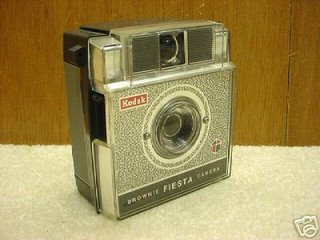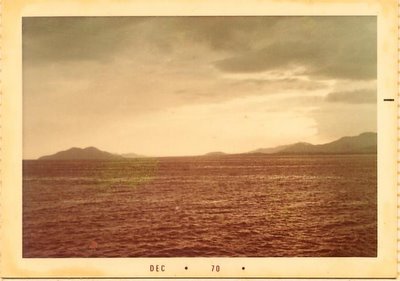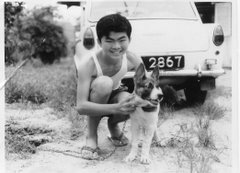I think many readers of Good Morning Yesterday like to take photos of places and plants of Singapore. Besides those you post on your blog, I am sure, like me you have many other photos in your collection. Why not share them with other Singaporeans?
Here is one neat place where you can do just that. It is the National Library Board's Just Share
website. It was introduced to me by my fellow Friend of Yesterday, the
Rambling Librarian, Ivan Chew. Ivan incidentally was the first Singaporean blogger to recommend Good Morning Yesterday to the folks at Tomorrow.sg labelling me 'Singapore's oldest blogger' back in 2005 when I had just started this blog.
I have just begun to share my photos. For a start I will limit my photos to what I labelled "Peaceful Singapore". I will focus on places that are quiet and peaceful (and green), such as Lorong Semangka in Choa Chu Kang and Old Jurong Road.
I have one complaint though. How come they did not have a category on Heritage or Yesterday's Singapore?
Oh; I forgot to mention - you may even win some prizes through your photos. You can't get more Singaporean than that, can you?
.JPG) The next generation of photo albums as far as I can recall had a sticky surface onto which you placed your photos. It is overlaid by a large clear plastic sheet. I regret using this type of album because after some years my photos got stuck to the pages. Any suggestions for removing them without damaging my precious old photos?
The next generation of photo albums as far as I can recall had a sticky surface onto which you placed your photos. It is overlaid by a large clear plastic sheet. I regret using this type of album because after some years my photos got stuck to the pages. Any suggestions for removing them without damaging my precious old photos? .JPG) The next type photo albums came with individual plastic pockets. I still have several of them. But the ones I liked most were those which I bought in Japan. During my three-and-a-half month training in Japan in 1985, I took several photos and filed them in these albums. I liked the space provided at the side for you to write your notes. I bought a ten-volume set which came with a neat box file. I am glad to note that my 1985 photos are all still in good condition.
The next type photo albums came with individual plastic pockets. I still have several of them. But the ones I liked most were those which I bought in Japan. During my three-and-a-half month training in Japan in 1985, I took several photos and filed them in these albums. I liked the space provided at the side for you to write your notes. I bought a ten-volume set which came with a neat box file. I am glad to note that my 1985 photos are all still in good condition..JPG) Today, in the digital age, I keep most of my photos as images on my hard disk. I find online albums like Flickr.com extremely useful for sharing large numbers of photos with many people. Unfortunately many people of my generation have not kept up with the times. For example, in my church I am in charge of sharing photos of important events with our members. When I uploaded the photos onto Flickr and emailed them the guest pass to access these photos; many did not know how to download the photos. I offered to teach them, but suggested that it was best that they consulted their children.
Today, in the digital age, I keep most of my photos as images on my hard disk. I find online albums like Flickr.com extremely useful for sharing large numbers of photos with many people. Unfortunately many people of my generation have not kept up with the times. For example, in my church I am in charge of sharing photos of important events with our members. When I uploaded the photos onto Flickr and emailed them the guest pass to access these photos; many did not know how to download the photos. I offered to teach them, but suggested that it was best that they consulted their children. Hallo I would like to introduce myself.
Hallo I would like to introduce myself. The handwritten notes read: “Strangely miserable picture a few weeks after arrival at Yio Chu Kang!”
The handwritten notes read: “Strangely miserable picture a few weeks after arrival at Yio Chu Kang!”
 The handwritten notes read: “Birds eye view of the island city from the height of the Cathay Building”
The handwritten notes read: “Birds eye view of the island city from the height of the Cathay Building” Though now approaching my eightieth year I still travel extensively when my work as an advertising artist permits. Journalists with whom I have worked and count as friends say that I have enough material for a book and would hate to think that on my demise this unique and valuable archive might be lost forever.
Though now approaching my eightieth year I still travel extensively when my work as an advertising artist permits. Journalists with whom I have worked and count as friends say that I have enough material for a book and would hate to think that on my demise this unique and valuable archive might be lost forever. A slide is a film negative mounted on a stiff rectangular frame. To show the image to a group in a classroom or a conference hall, you need to mount the slide on a carousel and project the images onto a screen using a slide projector.
A slide is a film negative mounted on a stiff rectangular frame. To show the image to a group in a classroom or a conference hall, you need to mount the slide on a carousel and project the images onto a screen using a slide projector. Using the slide projector can also give rise to many problems. If you placed the slide into the carousel in the wrong position, the picture would come up wrong; either upside-down or front-to-back. A trick I used was to draw a small stick figure at the lower corner of my slide. When the slide is positioned correctly, you should be able to see the man standing upright. Thus, at one glance, you can spot any slide that has been positioned incorrectly in the carousel. In 5S jargon, this is known as visual control (mede miru kanri in Japanese).
Using the slide projector can also give rise to many problems. If you placed the slide into the carousel in the wrong position, the picture would come up wrong; either upside-down or front-to-back. A trick I used was to draw a small stick figure at the lower corner of my slide. When the slide is positioned correctly, you should be able to see the man standing upright. Thus, at one glance, you can spot any slide that has been positioned incorrectly in the carousel. In 5S jargon, this is known as visual control (mede miru kanri in Japanese).

 So you can see why I took to digital photography very happily when the technology came along. But first I had to convert some of my slides to jpeg images. I remember paying a hefty sum for the service.
So you can see why I took to digital photography very happily when the technology came along. But first I had to convert some of my slides to jpeg images. I remember paying a hefty sum for the service. This is a negative of one of my passport photos. I wonder if kids born in this century even know what a negative looked like.
This is a negative of one of my passport photos. I wonder if kids born in this century even know what a negative looked like.




 I doubt any of the above-mentioned studios are still around today. Would my readers know?
I doubt any of the above-mentioned studios are still around today. Would my readers know?

 This is my very first colour photo taken from a ferry to Penang in December 1970. At that time the Penang Bridge was not constructed yet.
This is my very first colour photo taken from a ferry to Penang in December 1970. At that time the Penang Bridge was not constructed yet.  This is a full-page advertisement by Standard Colour Centre in the 1993 street directory. They had branches all over Singapore.
This is a full-page advertisement by Standard Colour Centre in the 1993 street directory. They had branches all over Singapore.
.JPG) This is my last film camera (left), which I believe is still in working condition. It’s a Canon EOS 1000F. I have placed it sided-by-side with my new EOS 400 for comparison. Many happy moments with my wife and kids were captured by this trusty, (and now dusty) Canon. The next shot shows the film loading compartment.
This is my last film camera (left), which I believe is still in working condition. It’s a Canon EOS 1000F. I have placed it sided-by-side with my new EOS 400 for comparison. Many happy moments with my wife and kids were captured by this trusty, (and now dusty) Canon. The next shot shows the film loading compartment.+Chien+Pu+Camp+@+Heng+Chun+%5BMar+1977%5D.jpg)
















